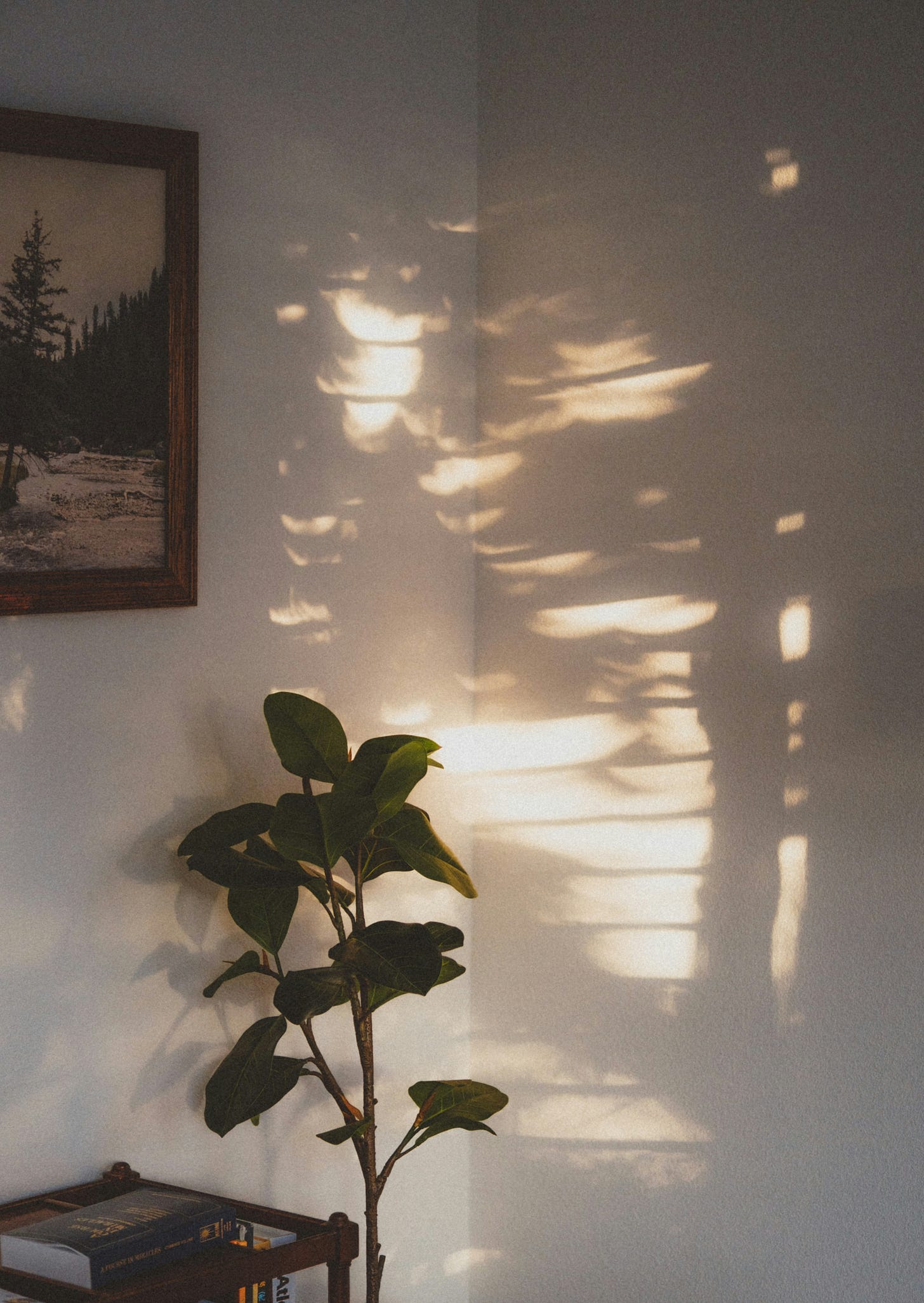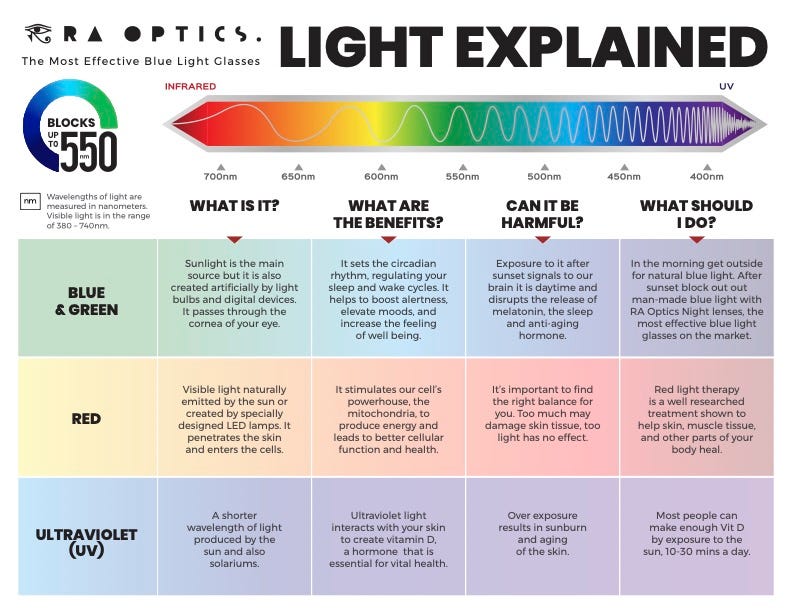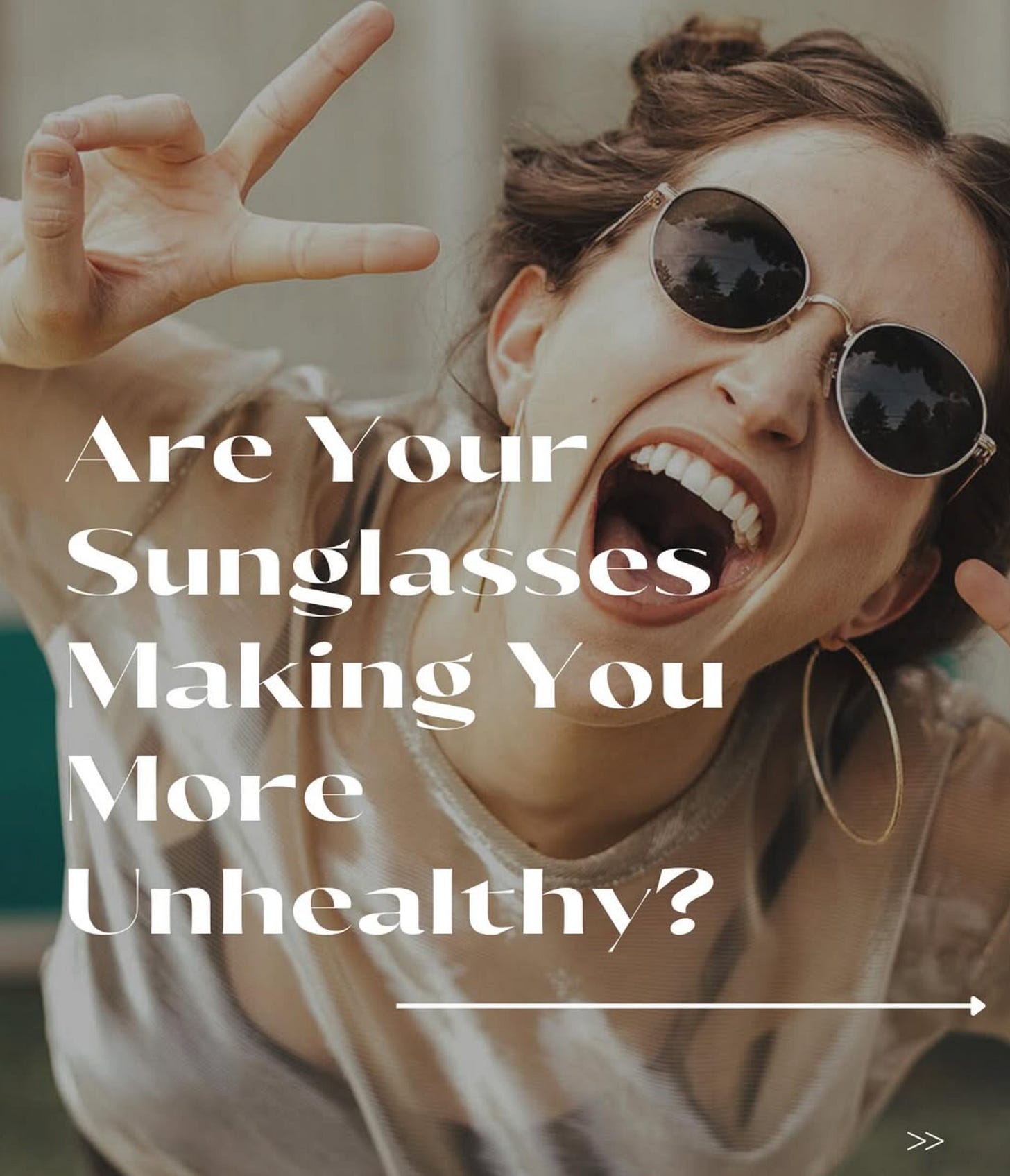Challenge #4: Light Hygiene
Light Hygiene 101: A Simple Way to Boost Mood, Sleep, and Energy
If I had to make a prediction, light hygiene would be one of the biggest topics of 2025.
I promise I’m not writing this because it’s trending.
Light is one of the more critical aspects of health. Of course, it took exposing ourselves for years to more and more “unhealthy” forms of light to realize that not all light carries the same healing benefits.
Some light is causing great harm to our bodies—and no, the unhealthy forms of light are not (ever) coming from the sun. The sun has been villainized for reasons that are not related to it at all.
Unfortunately, our modern light exposure is contributing to significant health issues, including:
Metabolic dysregulation
Hormonal imbalances
Poor sleep quality
Mental health disorders
When your sleep is disrupted, it creates a domino effect of dysfunction in your body—from mood disturbances to appetite irregularities. Recent studies, including the largest to date, have revealed alarming links between artificial light exposure and mental health.
Scientists found that greater night-time light exposure was associated with increased risk for major depressive disorder, generalized anxiety disorder, PTSD, psychosis, bipolar disorder, and self-harm behavior.
According to lead reseracher, “our biology functions most optimally with bright natural light during the day (sunlight, not bright artificial light) and with little to no light at night (which is why we block it).” (source)
Healing light is no longer a natural part of life; we must actively incorporate it into our routines. This is where the concept of light hygiene comes in.
This Week’s Challenge: 5 Minutes of Morning Sunlight
This simple, free challenge is more impactful than it might seem. All I ask is that you spend five minutes exposed to raw morning sunlight. Here’s how:
Go outside. Let the morning sun hit your skin and, most importantly, your eyes.
Avoid barriers. Glass, sunglasses, and contacts block many of the sun’s benefits, remove them for the full benefit.
Adapt to your environment. If it’s cold, roll down your car window during a morning commute or school drop-off.
Why does this work? Morning sunlight triggers processes in your body that improve energy, mood, sleep, and even appetite.
My husband, a self-proclaimed health skeptic, took this challenge, and his results were remarkable. I'll share how to learn about testimonial below. Plus, I have discount codes for you from my favorite light hygiene products — including the light bulbs we use in our house.
Light and Its Effects on the Body
Light is more than brightness. It’s a spectrum of colors, each with different wavelengths and effects on the body. Most specifically, the time of these wavelengths changes your health — for good or for bad.
Sunlight comprises a wide array of colors, whose intensities vary throughout the day. Blue light rays are stronger in the morning and at midday, promoting alertness. Later in the day and at dusk, blue light is less prominent, promoting relaxation (source).
Fun fact you didn’t know you needed:
Blue light is the reason the sky is blue. It’s not necessarily because it emits more blue light than other colors on the spectrum but because of how they are scattered and what we perceive.
They sky is blue because the Earth's atmosphere scatters blue light from the sun more than other colors, making the sky appear blue when we look up at it; this phenomenon is called Rayleigh scattering (source).
However, towards dusk or sunset, you will notice the sky's blueness turning pink. When this occurs, the sun's height shifts, emitting more red light.
As the blue light gets scattered away by the atmosphere due to the low angle of the sun, leaving the longer wavelengths like red and orange to dominate the color we see; this is why the sky appears more red and pink during sunset.
The wavelength or color of the light and the amount we’re exposed to have different interactions on the body.
The different wavelengths emitted throughout the day interact with our bodies, impacting our circadian rhythm. This 24-hour cycle regulates a number of bodily functions, including sleep patterns, metabolism, hormone release, digestion (and appetite), and mood and alertness.
Are you starting to see why this is such a big deal?
The health implications of different light wavelengths.
Light is a spectrum of colors, each with a different amount of energy and wavelength. Red light has longer wavelengths and less energy, while blue light has high energy and shorter wavelengths.
Blue light is not bad. It is actually really important— of course, at the right times.
Blue Light: The Good and the Bad
Benefits:
Regulates your circadian rhythm (body clock)
Stimulates cortisol release for healthy stress responses
Boosts alertness, energy, and focus
Drawbacks: When exposed to blue light after sunset, it:
Inhibits melatonin production
Disrupts sleep patterns
Triggers mitochondrial dysfunction, which can lead to issues like obesity, diabetes, anxiety, and even neurodegenerative diseases.
In summary, blue light is great at the right time and terrible at the wrong time.
Red Light: The Healing Powerhouse
Benefits:
Supports mitochondrial health (cell energy production)
Prepares cells for UV exposure
Repairs cells after UV exposure
I think the preparation for UV light exposure and repair is wildly cool and definitely underappreciated.
Perhaps we need to stop blaming UV light for health problems and start to recognize that it’s not the sun to blame but our poor lifestyle habits that take something good and make it bad.
Light hygiene isn’t about avoiding light, it’s using light at the right times for maximum benefit. And it’s focusing on the natural forms of light more than the artificial!
Speaking of artificial light, let’s talk about LED bulbs.
The Problem with LED Lights
Did you know LED bulbs flicker?
LED bulbs often flash at rates we can't see because they use a technology called "Pulse Width Modulation (PWM)" which rapidly switches the LED on and off at a very high frequency, creating a perceived constant light while the actual light is rapidly pulsing, too fast for the human eye to detect.
The flicker in LED light refers to quick fluctuations in brightness occurring several times per second. The swift speed of the flicker often makes it invisible to the eye. However, it may have neurological and physiological effects on our bodies (source).
Though invisible to the naked eye, this rapid flashing can have neurological and physiological effects. Record an LED light in slow motion on your camera to see for yourself.
This constant flicker is yet another reason to rethink your lighting.
How to Practice Light Hygiene:
Because our exposure to natural light has diminished, and artificial light dominates, we need to take intentional steps to create healthy light rhythms.
Here’s how to start:
Get Morning Sunlight: Spend 5-15 minutes outside in the morning light without sunglasses or contacts.
Incremental Exposure: Take it up a notch by adding 1-2 minutes (minimum) of midday sunlight and 5-10 minutes of evening light at sunset.
Turn Off Screens at Night: Limit screen time after sunset or use red-light settings. I recommend changing the screen color on your devices to red at night. It’s not a perfect blue light blocker, but it helps!
Embrace Darkness: Let it be dark and cozy. Instead of using your overhead lighting, opt for lamps or candles at night.
Use Your Lights As Little As Possible All Day: Sit by a window and let the natural light fill your office or home during the day. At night, only use the bare minimum lights you need.
Make Your Sleeping Enviornment Pitch Black (this includes your children): Invest in black-out curtains, remove devices and alarm clocks that glow, and make your sleeping environment as dark as possible. You can even use black electrical tape to blackout any small lights.
Stop Using Sunglasses: Read why below.
Switch Lightbulbs: Replace LED lights with circadium light bulbs that emit red or orange light in the evening. Even incandescent bulbs would be better than LED.
Invest in Red Light Devices: Use red light therapy to support recovery and relaxation.
Invest in Blue Light Blocking Glasses: I saved the best for last because this is easy to take with you and support you continuously when living in an otherwise normal light. And no, your clear lens blue light-blocking glasses are NOT working. Invest in something that actually works (the lenses will be tinted yellow or red).
Why Sunglasses and Contacts Block Sunlight’s Benefits
Your retina is the main point of contact needed to reap the benefits of sun exposure. Your retina is connected to the hypothalamus, the master circadian regulator of your body (source). When natural light penetrates your retina, it:
Regulates your circadian rhythm
Balances hormones
Stimulates dopamine release (yes, sunlight makes you happy!)
However, sunglasses, contacts, and most glasses block this process. Sunglasses are making you more unhealthy (and they’re hard on your metabolism). Gradually work to reduce your reliance on them to allow sunlight to do its work.
**This is a process that will take time. Start by avoiding them during the morning and evening hours, using them only during high points of sunlight exposure. If outside, reply on hats that shade your eyes rather than block them.
Product Recommendations
To take your light hygiene to the next level, consider these tools:
Blue Light Blocking Glasses: Look for high-quality options with red lenses for nighttime or yellow lenses for daytime, I recommend Ra Optics. They are expensive, but they actually work. They are incredibly high quality. You can even get the lenses with your specific prescription. Use the code: LIVINGWELL at checkout for an extra 10% off your order.
Circadian Light Bulbs: We switched to using lamps at night and use these light bulbs and turn off all of our overhead lights. These bulbs have a setting for daylight, dusk, and nighttime. Again, if you can’t afford to replace your whole house’s light bulbs, put them in areas you spend most of your time at night. Use the code: LIVINGWELL at checkout for an extra 10% off your order.
Red Light Therapy Devices: Ideal for recovery and relaxation after high artificial light exposure. I have had my JOOV light for 7 years and it’s still a part of our nighttime routine. Use the code: THELIVINGWELL at checkout for an extra 10% off your order.
Final Thoughts
Light hygiene is more than a trend; it’s a necessity for optimizing health. If you’re overwhelmed, start with the basics: get your daily dose of morning sunlight. Pay attention to how it impacts your sleep, mood, and energy. Small changes can lead to significant transformations.
Ready to take the challenge? Let me know how it goes for you!
For more inspiration, watch the video featuring my husband’s testimonial about his experience with morning sunlight. It will be posted to the chat tomorrow. His story might convince you to give it a try!








Where can we find your husband’s testimonial?